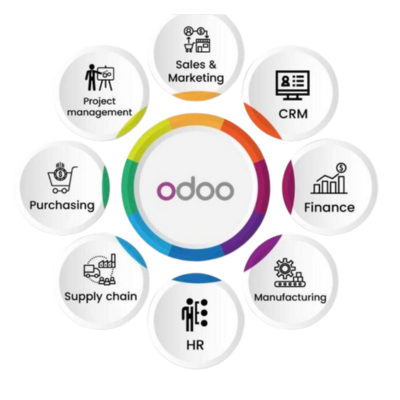Implementing Odoo for manufacturing holds immense potential for streamlining operations, but it presents unique challenges that businesses must navigate carefully. With this detailed blog, we’ll explore these hurdles and how to address them, ensuring a smooth transition and a successful implementation. Our approach breaks down complex ideas into manageable insights, while maintaining readability and flow.
Introduction
Manufacturing industries face continuous pressure to improve productivity, manage costs, and optimize workflows. Implementing Odoo ERP offers manufacturers a scalable and customizable solution to meet these needs. However, transitioning to a new ERP system is rarely straightforward. This guide dissects the main challenges and presents solutions to overcome them, ensuring that the integration of Odoo into your manufacturing processes is both seamless and successful.
1. Understanding the Key Challenges in Odoo ERP Implementation

- Complex Manufacturing Processes
- Challenge: Manufacturing processes are typically multi-layered and complex, making it difficult to adapt a new system to existing workflows.
- Solution: Customizing Odoo’s modules and ensuring tailored solutions align with current processes can help, but it requires experienced developers.
- Stat Insight: Nearly 80% of manufacturing ERP implementations need customization to fit specific industry needs (source: Panorama Consulting).
- Data Migration Difficulties
- Challenge: Moving vast volumes of historical data to Odoo is challenging. Misaligned data formats can lead to data integrity issues, hindering smooth implementation.
- Solution: Engage in a data cleansing exercise before migration, and work with a skilled Odoo consultant to ensure data accuracy and compatibility.
- Real-World Example: A mid-sized manufacturing company reduced errors by 35% through careful data cleansing before Odoo integration.
- Challenge: Moving vast volumes of historical data to Odoo is challenging. Misaligned data formats can lead to data integrity issues, hindering smooth implementation.
- Integrating Odoo with Legacy Systems
- Challenge: Manufacturers often rely on legacy systems that don’t seamlessly integrate with Odoo.
- Solution: Utilizing Odoo Integration Services can simplify connectivity between old systems and Odoo, allowing for smooth data flow and real-time updates.
- Challenge: Manufacturers often rely on legacy systems that don’t seamlessly integrate with Odoo.
- User Resistance and Training Needs
- Challenge: Employees accustomed to legacy systems may resist change, impacting productivity during the transition phase.
- Solution: Conduct comprehensive training sessions to familiarize staff with Odoo’s interface. Nearshore Odoo Consulting services can be beneficial here for providing ongoing support and training.
- Challenge: Employees accustomed to legacy systems may resist change, impacting productivity during the transition phase.
- Customization and Development Requirements
- Challenge: Generic ERP solutions may not address every specific requirement of a manufacturing firm, necessitating customizations.
- Solution: Partnering with experienced providers of Odoo Development Services can streamline the process of tailoring the system to fit unique requirements.
- Challenge: Generic ERP solutions may not address every specific requirement of a manufacturing firm, necessitating customizations.
2. Strategic Solutions for Successful Odoo ERP Implementation

Pre-Implementation Planning
- Conduct a Thorough Needs Analysis: Before implementation, perform a detailed gap analysis to map out essential functions and identify potential roadblocks.
- Build a Dedicated Implementation Team: A team comprising IT personnel, Odoo consultants, and senior stakeholders can ensure decisions are made swiftly and challenges are addressed promptly.
Data Migration Best Practices
- Data Mapping and Cleansing: Prior to migration, ensure that legacy data is mapped accurately to Odoo fields. Cleansing data eliminates redundant entries, enhancing data quality.
- Pilot Testing: Test data migration with a subset of records before full-scale transfer. This step is crucial to catch errors and improve data migration accuracy.
User Training and Change Management
- Involve End Users Early: Allowing users to interact with Odoo’s demo version builds familiarity and reduces resistance.
- Offer Tailored Training Programs: Conduct department-specific training to cater to varying levels of technical familiarity among users.
- Key Insight: Companies that invest in user training report a 20-30% improvement in ERP adoption rates.
3. Addressing Customization Challenges with Odoo Development Services
Manufacturing companies often require highly specific customizations to streamline workflows. Odoo’s modular nature allows for flexibility, but professional support is invaluable.
- Partnering with an Odoo Development Company: For complex customizations, hire experienced Odoo developers who understand both the technical and industry-specific requirements.
- Benefits of Customization: Customizing Odoo allows manufacturers to add unique functionalities—such as advanced scheduling, quality control features, and inventory management—directly into the ERP framework.
4. Integrating Odoo with Manufacturing Equipment and IoT Devices

To enable real-time data collection and machine monitoring, Odoo ERP needs integration with IoT devices and manufacturing equipment.
- Importance of Integration: Integration enables real-time data flow between machines and ERP, empowering informed decision-making and enhancing productivity.
- Solution: Leverage Odoo Integration Consultants who can link Odoo with IoT systems, providing automated data updates and minimizing manual intervention.
- Statistic: Manufacturing facilities that adopt IoT integrations see a 30% increase in equipment effectiveness.
5. Ensuring a Smooth Post-Implementation Transition
Once Odoo is implemented, continued monitoring is essential to ensure the system’s effectiveness. A structured post-implementation strategy can solidify long-term success.
- Establish Clear KPIs: Define performance metrics, such as production cycle time, material cost reduction, and on-time delivery rate, to evaluate Odoo’s impact.
- Monitor System Performance and Scalability: With Odoo’s scalable architecture, as your business grows, additional modules can be implemented to support expanding needs.
- Provide Ongoing Support: Retain offshore Odoo consulting for continuous support, troubleshooting, and system updates.
Expert Odoo ERP Solutions Provider
Hire Expert Odoo Developers for Tailored ERP Solutions Today!

Conclusion
Implementing Odoo in manufacturing holds immense potential for improving efficiency, reducing costs, and enabling data-driven decisions. By addressing the above challenges, manufacturers can leverage Odoo to drive digital transformation effectively. However, the success of the implementation relies heavily on thorough planning, expert support, and continuous training.
For organizations seeking a tailored Odoo implementation, it’s essential to work with an experienced Odoo service provider that understands the unique demands of the manufacturing sector.
FAQs
What are the common challenges in implementing Odoo for manufacturing businesses?
The most common challenges include:
- Data Migration: Transferring existing data into Odoo without errors can be tricky.
- Integration with Existing Systems: If you’re already using other software, ensuring Odoo communicates smoothly with it might require custom development.
- Customization: Tailoring Odoo to your specific manufacturing needs can be complex, requiring technical expertise.
- Training Employees: Ensuring staff understand how to use Odoo effectively is critical for a successful implementation.
- Resistance to Change: Employees may be hesitant to adopt a new system, especially if they’re used to older ways of working.
How can businesses ensure smooth data migration when implementing Odoo?
To ensure smooth data migration:
- Work with experienced Odoo consultants who specialize in data migration.
- Plan and test the migration in stages, especially for large datasets.
- Use Odoo’s built-in tools to import data or hire a developer to create custom import scripts.
- Validate the data post-migration to ensure accuracy and consistency.
. What steps can businesses take to integrate Odoo with existing manufacturing systems?
Integration with existing systems can be approached in these ways:
- APIs: Use Odoo’s API capabilities to connect with other software.
- Custom Development: If necessary, develop custom modules or connectors to enable communication between Odoo and existing systems.
- Odoo Partners: Work with an experienced Odoo partner who understands integration requirements and can help ensure compatibility with other tools you use.
How do I customize Odoo to meet specific manufacturing needs?
Customization is one of Odoo’s strong points, but it requires understanding your manufacturing processes. Here’s how to customize:
- Odoo Studio: Use this tool for simple customizations, like adjusting workflows and adding fields.
- Custom Modules: For complex needs, consider hiring an Odoo developer to create custom modules tailored to your business.
- Configuration: Many features in Odoo, like production planning and inventory management, can be configured to match your requirements without coding.
. How can I overcome employee resistance to using Odoo in manufacturing?
Employee training is key to overcoming resistance. Here’s what helps:
- Comprehensive Training: Provide hands-on training sessions that cover everything from basic functions to more advanced features.
- Ongoing Support: Offer ongoing support and a helpdesk to answer any questions.
- Change Management: Highlight the benefits of Odoo, like automation and better data visibility, to motivate employees. Engage employees in the process to get their buy-in.















